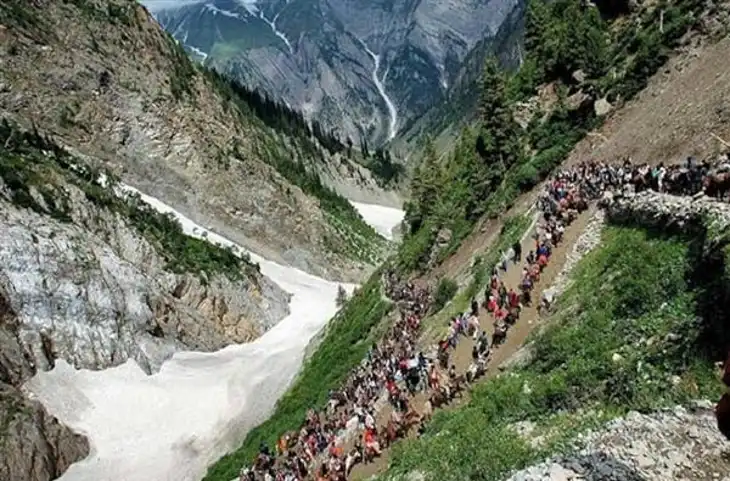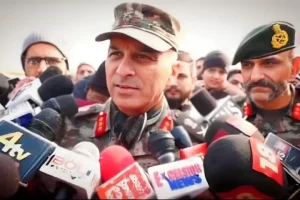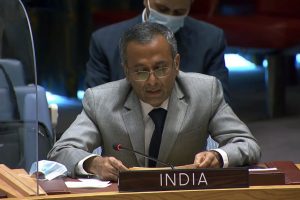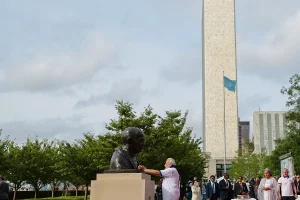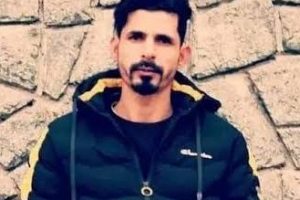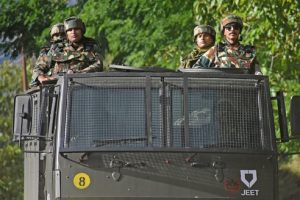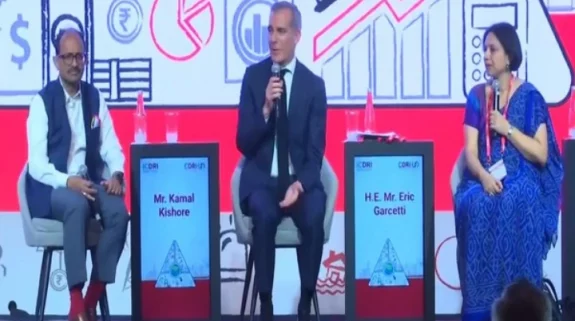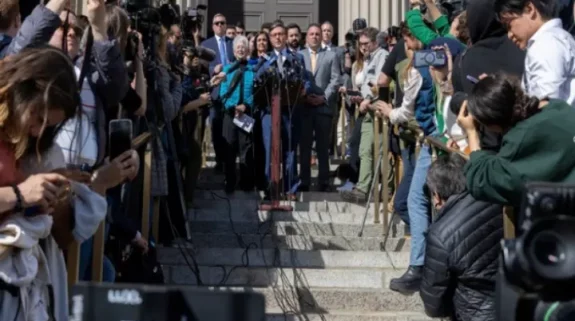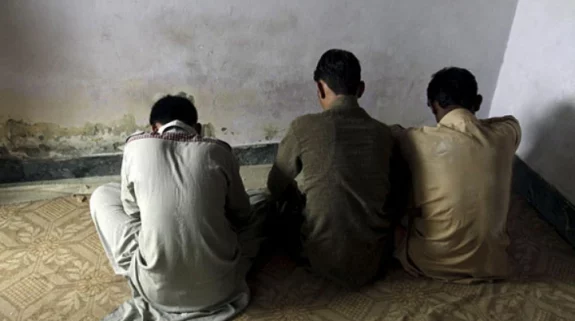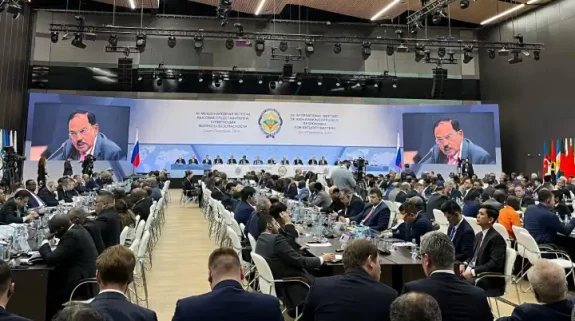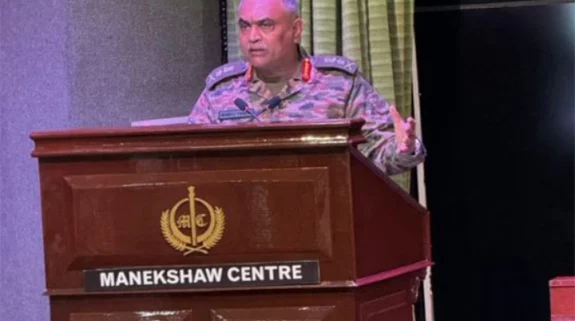While the 43-day long annual Amarnath Yatra commenced formally amid tight security from the traditional base camps of Nunwan (Pahalgam) and Baltal (Sonmarg) on Thursday, more than 35,000 local Muslims are as usual engaged with different arrangements and services of the pilgrimage.
Officials of Pahalgam Development Authority (PDA), besides Tourism and Revenue departments of the Union Territory government, revealed to INDIA NARRATIVE that the first batch of the pilgrims, comprising 15,000 devotees, had darshan and attended prayers at the Amarnath cave-shrine on Thursday. "On day one today, yatra operated from both tracks– Pahalgam and Baltal. The helicopter services too operated smoothly as the weather remained pleasant", a senior officer asserted. According to him more than 35,000 Kashmiri Muslims were currently associated with different arrangements and services to the pilgrimage.
Most of the service providers, estimated to be around 20,000, are pony owners from Anantnag, Kulgam and Kishtwar districts. Others include palanquin operators, private and government transporters, authorised vendors and shopkeepers, hoteliers, tent providers as also a large number of the employees from the government's Tourism, Revenue, Health, Telecommunication, Police, PDA, Power Development and other departments.
Significantly four days before the commencement of the pilgrimage, Prime Minister Narendra Modi said in his weekly broadcast that the local residents were associated with the yatra "with the same enthusiasm and devotion as that among the devotees".
One among the yatra managers is Mohammad Altaf Malik of Batkot, Pahalgam, who is an employee with the PDA. Malik is a descendant of Bota Malik who is said to have discovered the holy cave over the Amarnath mountain at an altitude of 12,756 ft in 1850 CE. Altaf Malik is now supervising the PDA's helicopter services for the pilgrims at Pahalgam. These services operate on fair weather days between Pahalgam and Panjtarni on one side and Baltal and Panjtarni on the other side.
The holy yatra to the #Amarnath Shrine begins after a 2-year hiatus!
Lord #Shiva chose Amarnath cave to reveal Goddess Parvati the Amar Katha or the secret of his immortality.
It's a shining symbol of eternity characterising the supreme power of the universe.@LostTemple7 pic.twitter.com/vMhiF3y80c
— P C Mohan (@PCMohanMP) June 30, 2022
From Panjtarni onwards, the pilgrims are carried by ponies or palanquins over a pedestrian track of 5 kms. Small helicopters occasionally carrying VVIPs fly straight up to a restricted helipad near the holy cave.
IGP Kashmir and SSP Anantnag visited Holy Cave and Yatri camp Panjtarni. Held security review meeting with officers from Army, CRPF, BSF, ITBP, JKP, NDRF and civil administration. Later on, IGP physically inspected deployment of forces on the ground and (1/2) pic.twitter.com/LvHXKVeW6t
— Kashmir Zone Police (@KashmirPolice) June 28, 2022
"For about 18 years, I looked after the yatra arrangements at Panjtarni and Sheshnag. Even in 2019, when the yatra was scuttled after 31 days (ahead of the abrogation of Article 370) and my father passed away, I was on duty at Panjtarni. More than our duty as the government employees, this yatra is a matter of faith and devotion for us", Altaf said. He narrated how his father, Ghulam Mohammad Malik, was not only well known and respected but also seen with reverence by lakhs of Hindu devotees in Maharashtra, Gujarat, Punjab and other States. "Before 1990, once Shiva Sena founder Bal Thackeray ji invited my father to Mumbai. They all had tremendous regard for our forefather Bota Malik's discovery of the holy cave and the services provided to the yatra by several generations of the Malik family", Altaf Malik added.
According to Altaf Malik, and as the legend goes, Bota Malik, the shepherd from Batkot, was given a sack of charcoal by a hermit deep into the Pahalgam woods. When he opened the bag back at his home, he found the coal turned into gold. When he went back to give his gratitude to the hermit, he found the cave at that place. Altaf has also heard another version from his father and grandfather. "Those days a Hindu deity perched on a bull used to patrol on the Dal Lake. One Said Wani caught the bull by his tail and asked for Lord Shiva's darshan. The hermit told him to meet Bota Malik near his village in Pahalgam. Said Wani met with Bota Malik. Bota Malik was given the track in a dream by Lord Shiva. He guided Said Wani to the cave where both had Lord Shiva's darshan. When Maharaja Gulab Singh heard about it, he entrusted the responsibility of the shrine and yatra management to Bota Malik and his progeny", Altaf said.
According to the legend, Shiva revealed the secrets of immortality to his divine consort Parvati at the holy cave. The place is revered as abode of Mahamaya Shakti Peetha, one of the 51 Shakti Peethas throughout South Asia that commemorate the location of the fallen body of Sati. Swami Vivekanand is said to have visited and paid his obeisance at the Amarnath cave in 1898. Every year during the yatra, devotees spot a pair of white pigeons at the cave. A massive ice lingam inside the cave develops during the yatra month of Shraavan and diminishes towards the middle of August.
According to Mohammad Afzal Malik, another member of the Malik family, even Prime Minister Jawaharlal Nehru would never visit the holy cave without the company of his grandfather Ghulam Ahmad Malik.
Farooq Abdullah's government in Jammu & Kashmir passed The Jammu and Kashmir Shri Amarnathji Shrine Act in the year 2000 as per the recommendations of an inquiry commission to create an independent board, with Governor as its Chairman, for management of the cave shrine and the yatra. The commission looked into the reasons for the death of 243 pilgrims in a natural calamity in August 1996.
Until the constitution of the Shri Amarnath Shrine Board (SASB) in 2001, the offerings and donations at the cave shrine used to be distributed as per a tradition equally among the Mahant, the Pandit Pujaris of Mattan and Ganeshpora and the Malik family of Batkot. The SASB offered a one-time settlement to the three equal stakeholders. While the Mahant Deepinder Giri and the Pandits, according to Altaf Malik, reconciled and accepted a particular amount of money, the Malik insisted to continue as the stakeholders.
"We went to the Special Tribunal but it did not issue a speaking order in the last 18 years. We have not received anything from the SASB. However, pending the dispute, the SASB engaged 5 or 6 of our boys against class 4th vacancies. It is a matter of grave injustice with the family which has discovered the cave shrine and provided service to the yatra from 1850 to 2001. But our sole demand is not compensation. We want to continue as the service providers. We used to distribute Amar Jal and other sacred things among the devotees. After 2001, this all was conducted by the SASB and our stake and role has been completely taken away. But we still go there as per our faith and attend the rituals", Altaf Malik said. He said that only one Governor (Lt Gen SK Sinha) once invited the Malik family and assured them restoration of their privileges around 2007 but that was never implemented.
Also Read: Amid tight security and a gap of two years, Amarnath Yatra is flagged off in Jammu






